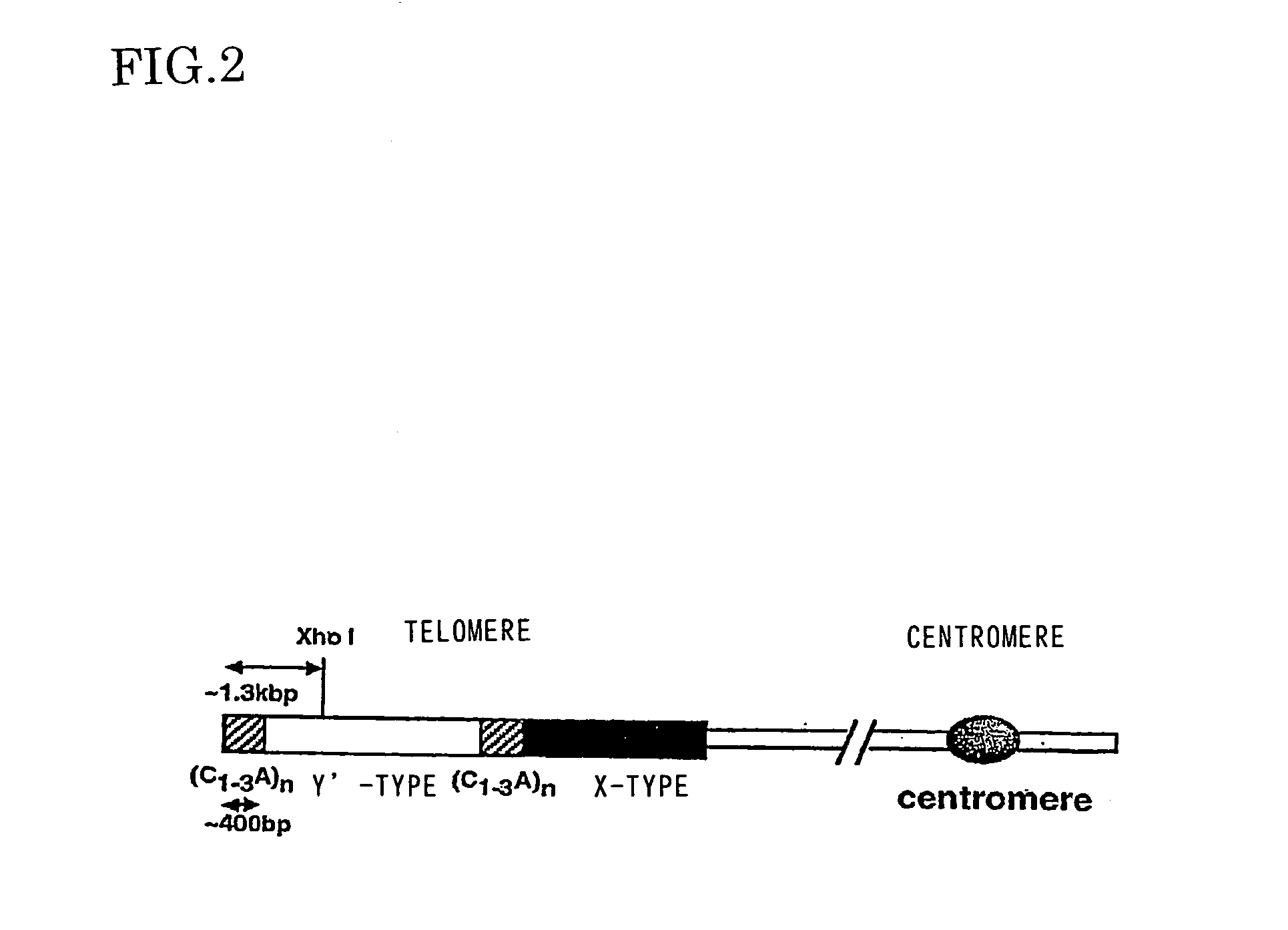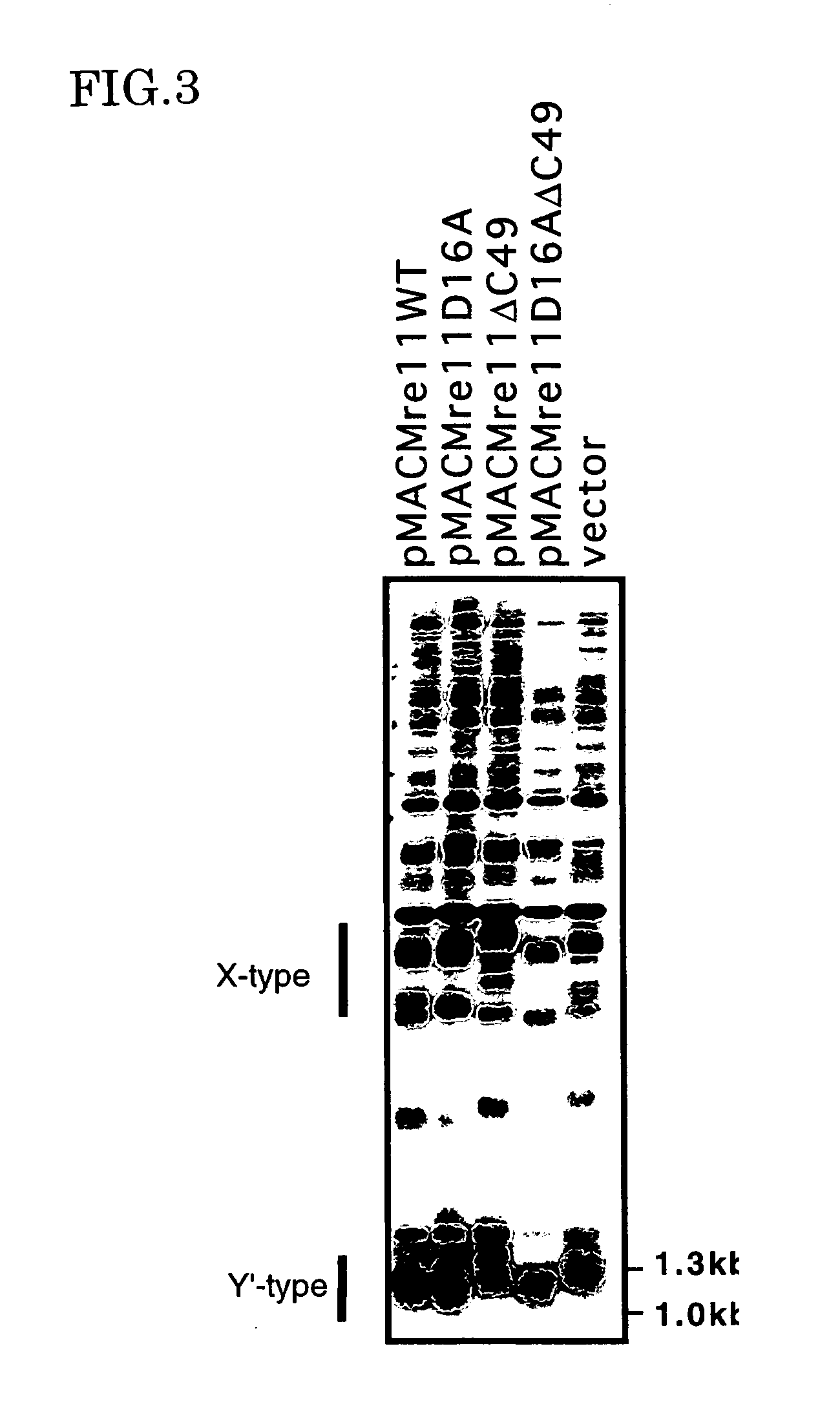Method of controlling telomere length
a technology of telomeres and telomeres, which is applied in the direction of peptides, drug compositions, peptides/protein ingredients, etc., can solve the problems of cell death, chromosome shortened by the size of rna primers,
- Summary
- Abstract
- Description
- Claims
- Application Information
AI Technical Summary
Benefits of technology
Problems solved by technology
Method used
Image
Examples
example 1
Preparation of a DNA Recombinant Vector Encoding a Yeast Mre11 Protein and a Variant Yeast Mre11 Protein
(1) Preparation of a DNA Encoding Mre11 Protein
[0064]E. coli cells containing a genomic DNA library of yeast DBY939 strain constructed by using a YEp24 yeast—E. coli shuttle vector (constructed by M. Carlson) were plated onto LB agar medium containing ampicillin, and the obtained colonies were transfer to a nylon membrane, then the DNA derived from the colonies onto the membrane in accordance with a conventional method. The polymerase-chain-reaction (PCR) was performed with oligonucleotides as primers, each of which has a sequence corresponding to the DNA sequence encoding the N-terminal region and the C-terminal region of the MRE11 protein respectively, and the genome DNA of wild-type blast yeast strain ORD149 as a template. The obtained DNA fragment was cloned in a vector for E. coli, and the fragment excised from the vector was labeled using [32P]-dCTP. This probe was conta...
example 2
Transformation of Yeast with a Recombinant Vector
[0067] Transformation of yeast Saccharomyces cerevisiae ORD149 strain (a diploid having arg4rv / arg4bg and trp1-289 / trp1-289 alleles), which was given by Dr. Alain Nicolas (Institut Curie, France). with the recombinant vector obtained in Example 1 was conducted, as follows. The yeast strain was washed with 1M sorbitol and mixed with the vector. After the DNA was introduced into the yeast cells by electroporation, the cells (the yeast strain having mutation in trp1 gene and the vector having a selectable marker TRP1 gene) were allowed to grow on a tryptophan-free minimal agar medium containing 1M sorbitol (, and the colonies having the plasmid were selected. These yeast colonies were further grown in a medium containing 0.2 μg / ml of aureobasidin.
example 3
Analysis of Telomere Length
[0068] The telomere length of each transformant obtained in Example 2 was analyzed as follows. That is, a yeast cell including only pMAC561aur vector and transformant yeast cells which were obtained in Example 2, each having one of the recombinant vectors, pMACMre11WT, pMACMre11D16A, pMACMre11ΔC49, and pMACMre11D16AΔC49 were cultured for 12-16 hours in a nutrient medium containing 0.2 μg / ml of aureobasidin, and the cells were harvested. Next, in accordance with a conventional method, genomic DNA was extracted from the cell, and after digestion by a restriction enzyme XhoI, the DNA fragments were separated by agarose gel electrophoresis. The DNA fragments on the agarose gel were transferred onto a nylon membrane with vacuum under an alkaline condition, and the membrane was analyzed by Southern hybridization according to a method of Church et al. [Church, G. M. et. al.: Proc. Natl. Acad. Sci. U.S.A., 81: 1991-1995(1984)]. As a probe, an oligonucleotide lab...
PUM
| Property | Measurement | Unit |
|---|---|---|
| temperature | aaaaa | aaaaa |
| temperature | aaaaa | aaaaa |
| length | aaaaa | aaaaa |
Abstract
Description
Claims
Application Information
 Login to View More
Login to View More - R&D
- Intellectual Property
- Life Sciences
- Materials
- Tech Scout
- Unparalleled Data Quality
- Higher Quality Content
- 60% Fewer Hallucinations
Browse by: Latest US Patents, China's latest patents, Technical Efficacy Thesaurus, Application Domain, Technology Topic, Popular Technical Reports.
© 2025 PatSnap. All rights reserved.Legal|Privacy policy|Modern Slavery Act Transparency Statement|Sitemap|About US| Contact US: help@patsnap.com



